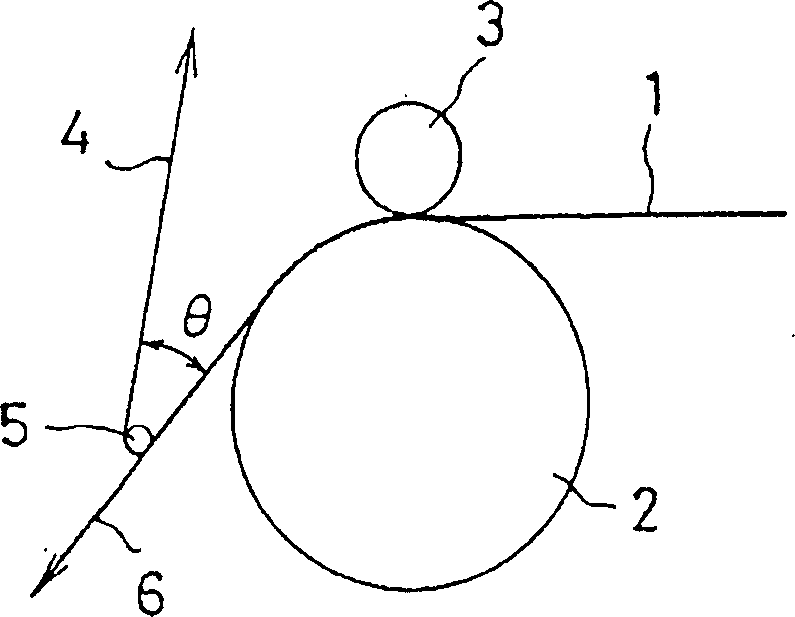Method for manufacturing optical elements
A technology of optical components and manufacturing methods, applied in optics, polarizing components, nonlinear optics, etc., capable of solving problems such as irregular peeling
- Summary
- Abstract
- Description
- Claims
- Application Information
AI Technical Summary
Problems solved by technology
Method used
Image
Examples
Embodiment
[0039] Hereinafter, the present invention will be specifically described based on examples, but the present invention is not limited by these examples.
[0040] Various analytical methods used in Reference Examples and Examples are as follows.
[0041] (1) Determination of optical parameters
[0042] The optical parameters of the twist angle and retardation (Δn·d) of the liquid crystal film were measured by polarized light analysis method. (Δn: birefringence constant, d: thickness of the liquid crystal layer of the liquid crystal film; unit nm)
[0043] (2) Determination of logarithmic viscosity
[0044] The measurement was carried out in a phenol / tetrachloroethane (60 / 40 weight ratio) mixed solvent at 30° C. using an Ubbelode viscometer.
[0045] (3) Determination of liquid crystal polymer composition
[0046] Dissolve the liquid crystalline polyester in deuterated chloroform, using a 400MHz 1 H-NMR (JNM-GX400 manufactured by JEOL Ltd.) was measured to determine the comp...
reference example 1
[0048] Synthesize the liquid crystal polymer substance (logarithmic viscosity=0.22dl / g, Tg=61 ℃) of formula (1) and (R)-3-methylhexane-1,6-bis containing formula (2) Optically active liquid crystal polymer substance (logarithmic viscosity=0.17dl / g) of alcohol unit.
[0049] The synthesis of these polymer materials is carried out by reacting acid chlorides corresponding to dicarboxylic acid units with diol compounds in the presence of triethylamine in o-dichlorobenzene solvent.
[0050] The liquid crystalline polymer solution-1 was prepared by dissolving 18.1 g of the obtained liquid crystalline polymer of formula (1) and 1.9 g of the liquid crystalline polymer mixture of formula (2) in 80 g of N-methylpyrrolidone.
[0051] Formula 1)
[0052]
[0053] Formula (2)
[0054]
[0055] * Optically active carbon
reference example 2
[0057] Using 80mmol terephthalic acid, 23mmol pimelic acid, 55mmol hydroquinone diacetate, 50mmol isopropyl catechol diacetate and sodium acetate as a catalyst, polymerized at 280°C for 2 hours under nitrogen atmosphere, Polymerization was carried out at 300° C. for 2 hours to obtain a liquid crystalline polymer substance of formula (3).
[0058] Then, the obtained liquid crystal polymer substance was dissolved in tetrachloroethane, and then reprecipitated with methanol to obtain 26 g of a purified liquid crystal polymer substance. The logarithmic viscosity of this liquid crystal polymer substance is 0.31dl / g. As a result of DSC measurement and polarizing microscope observation, the liquid crystal phase is a nematic phase, and the low temperature portion lower than the liquid crystal phase is a glass phase without a crystal phase. , Tg is 117°C.
[0059] 15 g of this liquid crystal polymer substance was dissolved in 85 g of tetrachloroethane to prepare a liquid crystal phase ...
PUM
| Property | Measurement | Unit |
|---|---|---|
| diameter | aaaaa | aaaaa |
| thickness | aaaaa | aaaaa |
Abstract
Description
Claims
Application Information
 Login to View More
Login to View More - R&D
- Intellectual Property
- Life Sciences
- Materials
- Tech Scout
- Unparalleled Data Quality
- Higher Quality Content
- 60% Fewer Hallucinations
Browse by: Latest US Patents, China's latest patents, Technical Efficacy Thesaurus, Application Domain, Technology Topic, Popular Technical Reports.
© 2025 PatSnap. All rights reserved.Legal|Privacy policy|Modern Slavery Act Transparency Statement|Sitemap|About US| Contact US: help@patsnap.com



